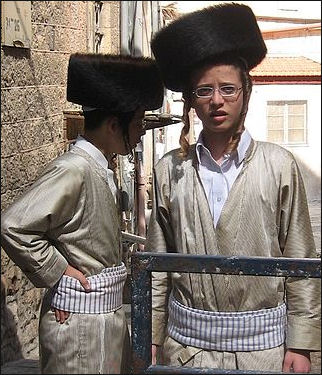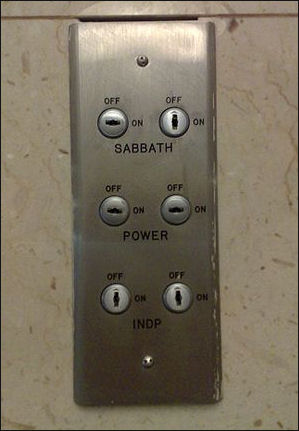Home | Category: Jewish Sects and Religious Groups / Jewish Sects and Religious Groups
ULTRA-ORTHODOX JEWS

Ultra-Orthodox Jews Religiously adherent Jews in Israel include the strict Orthodox Jews and the even stricter ultra-Orthodox Jews. Comprising only 10 to 15 percent of the Jewish population in Israel, they make a substantial portion of the population of Jerusalem and are well represented in the Jewish settlements in Palestinian territories. Many are Sephardim.
Ultra-Orthodox Jews take the Torah literally. For them God commands and they obey without questioning. There are many commandments, rules or prohibitions they have to abide by. Their primary reason for existence is to declare, “There is only one God.” Devout Muslims live by a similar code.
Many Ultra- Orthodox Jews treat Judaism as if it is were an exclusive club in which a select few belong. To qualify members have to follow rigid rules. Jews converted by non-Orthodox rabbis are not recognized. Liberal Jews on the other hand tend be more inclusive, recognizing almost anyone who calls himself or herself a Jew.
Book: "Memoirs of a Jewish Extremist" by Yossi Klein Halevi (Little, Brown and Co., 1995)
Judaism and History
Websites and Resources: Virtual Jewish Library jewishvirtuallibrary.org/index ; Judaism101 jewfaq.org ; torah.org torah.org ; Chabad,org chabad.org/library/bible ; BBC - Religion: Judaism bbc.co.uk/religion/religions/judaism ; Yivo Institute of Jewish Research yivoinstitute.org ; Jewish History: Jewish History Timeline jewishhistory.org.il/history Jewish History Resource Center dinur.org ; Center for Jewish History cjh.org ; Jewish History.org jewishhistory.org ; Internet Jewish History Sourcebook sourcebooks.fordham.edu
RECOMMENDED BOOKS:
“The Gerus Guide - The Step By Step Guide to Conversion to Orthodox Judaism” by Rabbi Aryeh Moshen Amazon.com ;
“How to Run a Traditional Jewish Household” by Blu Greenberg Amazon.com ;
“Holy Days: The World Of The Hasidic Family” by Lis Harris Amazon.com ;
“Conservative Judaism” by Behrman House Amazon.com ;
“Modern Conservative Judaism: Evolving Thought and Practice" by Rabbi Elliot N. Dorff, Rabbi Julie Schonfeld Amazon.com ;
“Reform Judaism: A Jewish Way of Life” by Charles A. Kroloff Amazon.com ;
“A Life of Meaning: Embracing Reform Judaism's Sacred Path” by Rabbi Dana Evan Kaplan Amazon.com ;
“Essential Judaism: Updated Edition: A Complete Guide to Beliefs, Customs & Rituals”
by George Robinson Amazon.com ;
“Living Judaism: The Complete Guide to Jewish Belief, Tradition, and Practice”
by Wayne D. Dosick Amazon.com ;
“Judaism: History, Belief and Practice” by Dan Cohn-Sherbok Amazon.com ;
“Living a Jewish Life: Jewish Traditions, Customs, and Values for Today's Families” by Anita Diamant, Howard Cooper, et al. Amazon.com ;
“To Be a Jew Today: A New Guide to God, Israel, and the Jewish People”
by Noah Feldman Amazon.com ;
“A History of the Jews” by Paul Johnson, Amazon.com
Characteristics of Ultra-Orthodox Jews
Ultra-Orthodox Jews have been described as “right-wing, xenophobic and anti-intellectual.” Their society has been called obsessed with appearances, lacking in compassion or kindness and deeply hypocritical and cruel in its rigid interpretations.” The ultra-Orthodox value adherence to religious doctrine more than hard work. They believe they have the right to violate the laws of the state because they follow higher laws.
Haredim (“Those who tremble”) are Jewish fundamentalists who strictly observe Jewish laws and customs and follow the dictates of their rabbis. They live apart as much as possible from the secular world, which they regard as intrinsically corrupt. Yeshivas is a term sometimes used to describe born-again Jews. A Yeshiva is a religious school.
The number of Orthodox Jews worldwide is now growing. In Israel, Orthodoxy rules the religious authority and the rabbinate and controls courts that make decisions about many legal matters. Only Orthodox rabbis are allowed to perform marriages, conversions and burials. Even secular Jews often regard Orthodox Jews as “real” Jews and are dismissive of liberal Jews.
Orthodox, Ultra-Orthodox and Hasidic Jews

Jews at the Western Wall in Jerusalem during Sukkot Professor Joshua Shanes wrote: Of all the Jewish denominations, the Orthodox groups are perhaps most misunderstood. They all share a commitment to Jewish law — especially regarding gender roles and sexuality, food consumption and Sabbath restrictions — but there are many divisions, generally categorized on a spectrum from “modern” to “ultra” Orthodox.[Source: Joshua Shanes, Associate Professor of Jewish Studies, College of Charleston, The Conversation, June 15, 2023]
Modern Orthodoxy celebrates secular education and integration into the modern world, yet insists on a relatively strict approach to ritual observance and traditional tenets of belief. They also tend to see Zionism — the modern movement calling for Jewish national rights, today connected to support for Israel — as part of their religious worldview, rather than just a political belief.
The ultra-Orthodox, on the other hand — sometimes called “Haredim” or Haredi Jews — advocate segregation from the outside world. Many continue to speak Yiddish, the traditional language of Jews in Eastern Europe, or to dress as traditional Jews did in Europe before the Holocaust.
This is especially true of Hasidic Jews, who make up about half of the ultra-Orthodox population worldwide. Hasidism is a mystical movement born in 18th-century Ukraine, but today mostly concentrated in New York and Israel. Hasidic Jews are known for being particularly strict about shunning secular culture and education, but they remain also a mystical movement focused on God’s close presence. They are divided into subgroups named after cities in Eastern Europe, and they follow leaders known as “Rebbes,” who wield enormous power in their communities.
Haredim are particularly committed to gender segregation, separating men and women beyond what previous Jewish traditions called for, and tend toward the strictest interpretation of Jewish law, even when traditional understanding of a rule has been more lenient.
Whether modern or Haredi, Orthodox Judaism sees itself as “traditional.” However, it is more accurate to say it is “traditionalist.” By this I mean that Orthodoxy is attempting to recreate a pre-modern religion in a modern era. Not only has Orthodox Judaism innovated many rituals and teachings, but people today have greater awareness that other types of life are available — creating a firm break with the traditional world Orthodoxy claims to perpetuate.
Ultra-Orthodox Jewish Lifestyle

Orthodox couple on Shabbat in Jerusalem The ultra-Orthodox lifestyle is rigidly organized to the point that individuals have to make few decisions. Orthodox Jews who follow their Holy Scripture to the letter continue to begin their day at sunset, by which they still set their clocks at twelve. Faithful are given instructions on when to wake up and wash, what to eat, and how to pray. Religious communities are hierarchal with rabbis and family leaders making decisions. There is little contact between males and females. Weddings are arranged and freedom and equality are given a low priority.
One ultra-Orthodox Jew told the Los Angeles Times with “the haradi education, you internalize, minimize your physical presence. You learn to be closed and withdrawn. If you walk the street with a friend, you may speak normally, but you lower your voice whenever you enter a store...I had an invisible wall around me.” For many ultra-Orthodox Jews their greatest joy is isolating themselves in small room and studying the Talmud.
Many ultra-Orthodox cloister themselves in their communities to protect themselves from exposure to the profane. Their ultra-Orthodox communities meet their needs and take care of them. Those that decide to leave the community often have great difficultly dealing with an independent life and making decision in secular society. Special organizations in Israel have been set up to help them.
Jewish Ultra-Orthodox Rules
The ultra-Orthodox view televison as a vehicle of profanity. Many ultra-Orthodox households don’t even have a television. Secular newspapers, novels, works by people like Freud and Darwin and pop music are regarded as corrupting influences and prohibited.
Some boys are so worried about the consequences of masturbating that they tie their hands to keep themselves from touching themselves.
Orthodox Judaism forbids men and women from praying together. In synagogues, men and women congregate in separate areas. In large gathering and men and women — segregated by sex — pray, dance and sing.
Ultra-Orthodox Views on Women

Sign pertaining to the segregation of women on buses One Ultra-Orthodox rabbi compared walking between two women with walking between two donkeys and advised men not to talk to women lest they take on the qualities of these inferior beings.
Women are treated by ultra-Orthodox Jews almost the same way women are treated by Muslim extremists. They are excluded from religious and non-religious activities, and required to remain sequestered inside the home and cover themselves when the go outside. The primary duty is raising children.
Women have been viciously insulted, spat upon and attacked on the streets by ultra-Orthodox for wearing trousers and exposing their arms. The confrontations become particularly common in the summer when they wear more revealing clothing in the hot weather.
Women are restricted and segregated in Judaism according to Jewish law and the traditional “division of roles.” Women have traditionally been segregated from men in synagogues during prayers by partitions and prevented from reading the Torah aloud at the Western Wall (which men can do). Orthodox rabbis have ruled that its inappropriate for women to wear skullcaps and prayer shawls and sing during worship or even pray aloud. Their voices are considered to be “provocative and rude.” According the Talmud the segregation of the sexes is based on a precedent established at the ancient Temple in Jerusalem, where most religious duties were carried out by men and women were regarded as a distraction. Unlike men, women are not obligated to attend daily prayers and their presence, except among Reformed Jews, does not count toward a “minyan” (congregation)
Jewish Ultra-Orthodox Rules and Women
Married women are required to conceal their hair. Some women shave their heads and then wrap their heads in plain scarves. Modesty squads patrol ultra-Orthodox neighborhoods such as Mea Shearim in Jerusalem, posting signs that read: "Passage Permitted Only to Women Dressed Modestly: Long Dress (longer than knee length), Long Sleeves (Beyond Elbow Length), Close Neckline.
In the Ultra-Orthodox world women can not become rabbis, serve as witnesses in rabbinical courts, nor obtain a religious divorce without permission from their husbands. There is no Hebrew word for a female rabbi because Orthodox Jews insist there is no such thing.
Ultra-Orthodox believe it is unclean for men to come in contact with women when they are having their period. In some ultra-Orthodox societies menstruating women are not allowed to leave their room or touch anyone or anything lest they make it unclean. For their entire period the women stay in their rooms. Food and drink are brought to them in specials dishes on special trays. Before their period they are required to take a ritual premenstrual bath.
Work and the Jewish Sabbath

Sabbath elevator on-off switch Orthodox Jews are not allowed to do anything on the Sabbath that can be construed as work. Jewish law, or Halakha, outlines 30 categories of work that can not be performed on the Holy Day, including driving a car, using a telephone, listening to radio, watching television, lighting fires, turning on lights,, writing, operating machinery. To satisfy fundamentalists Israel's national airline El Al does not fly on the Sabbath.*
Figuring out what is acceptable on the Sabbath and what isn’t has been described “one of the greatest complexities of Judaism. Even pushing the button of an elevator can be construed as work. Hotels in Israel have special elevators for the Sabbath which stop at every floor so no one does any work by pushing a button. The Institute of Science and Halacha has extended great effort into making even submarines Sabbath-compliant.
Completing an electrical circuit is considered work and ultra-Orthodox engineers have gone through great lengths to devise milking machines, metal detectors, motorized wheelchairs, medical machines, computers and alarms that work using circuits that remained closed all the time and thus can be used on the Sabbath. To get around the restriction on writing it engineers have developed pens whose ink disappears after a few days (writing is defined as leaving a permanent mark).
There are laws on the books in Israel that prohibit teenagers from working on the Sabbath. Ultra-Orthodox Jews want to see similar rules that prevent people from going to beach, visiting shopping malls and talking on their cell phones on the Sabbath. One ultra-Orthodox rabbis went as far as saying that Sabbath violators “will be killed.”
Karaites
The Karaites are a Jewish sect established by Anan Ben David in the A.D. 8th century in Babylon. They practice Judaism according to Halacha (Jewish Law) and do not accept the Mishna, Talmud or any other later interpretation of the Torah. The oldest surviving Jewish group that opposes rabbinic Judaism, they only recognize the Pentateuch, Prophets and Writings. Karaites are also known as the Baale Mikra, Israelite Karaitoes, Karaim, Karaite Jews and Qaraites. The word Karaite is derived from the Hebrew word “kara” , “to read.’
Most Karaites live in Israel and are of Egyptian origin. Their roots are matter of some dispute. Some believe they are descendants of the groups that existed in the second Temple period and were mentioned in the Dead Sea scrolls but most believe the sect came into existence when it was founded by Anan Ben David in the 8th century.
Karaites have traditionally lived in isolation from other Jews as well as from non-Jews. Whether they should be regarded as members of the Jewish community remains a matter of debate among Orthodox Jews. Maimonides scolded Jews who followed Karaite practices. In Israel, some Karaite customs have been made illegal by the Orthodox Chief Rabbanite, which is the exclusive legal authority there.
There are an estimated 8,000 to 30,000 Karaites in Israel. The numbers are inexact because the Karaites refuse to allow themselves to be counted for political and religious reasons. Before the founding of Israel a community of between 3,000 and 6,000 Karaites lived in Egypt. There were also some in Lithuania and the Crimea. Many were artisans, particularly goldsmiths and silversmiths. They have mostly emigrated to Israel, where many are working-class construction or factory workers or work as teachers or civil servants.. A few Karaites live in the United States and Europe. Around 100 Karaite families live in Istanbul.
See Separate Article: KARAITES africame.factsanddetails.com
Hasidic Jews
1917.jpg)
Jews in Khorostkiv in western Ukraine in 1917 Hasidic Jews are extremely pious and mystical ultra-Orthodox Jews known for their unusual clothing styles and preservation of 18th century customs and rituals. They are also known for their strong devotion to individual leaders, their ascetic lifestyles, ecstatic religion experiences, devotion to prayer and study and their emphasis on the traditional Jewish concept of simple delight in the service of God.
According to the BBC: “Poland and Central Europe saw the creation of a new Jewish movement of immense importance - Hassidism. It followed the example of the Baal Shem Tov (1700-1760) who said that you didn’t have to be an ascetic to be holy; indeed he thought that the appropriate mood for worship was one of joy. The movement included large amounts of Kabbalic mysticism as well, and the way it made holiness in every day life both intelligible and enjoyable, helped it achieve great popularity among ordinary Jews. However it also led to divisions within Judaism, as many in the religious establishment were strongly against it. In Lithuania in 1772 Hassidism was excommunicated, and Hassidic Jews were banned from marrying or doing business with other Jews. [Source: BBC]
Hasidic Jews usually speak Yiddish as their first language or their only language. They often live in isolated communities and rigidly follow strict rules but also lose themselves in mystical, ecstatic experiences with God that are not unlike those experienced by evangelical Christians.
See Separate Article: HASIDIC JEWS africame.factsanddetails.com
Image Sources: Wikimedia Commons
Text Sources: Internet Jewish History Sourcebook sourcebooks.fordham.edu “World Religions” edited by Geoffrey Parrinder (Facts on File Publications, New York); “ Encyclopedia of the World’s Religions” edited by R.C. Zaehner (Barnes & Noble Books, 1959); “Old Testament Life and Literature” by Gerald A. Larue, New International Version (NIV) of The Bible, biblegateway.com; Wikipedia, National Geographic, BBC, New York Times, Washington Post, Los Angeles Times, Smithsonian magazine, Times of London, The New Yorker, Reuters, AP, AFP, Lonely Planet Guides, and various books and other publications.
Last updated March 2024
